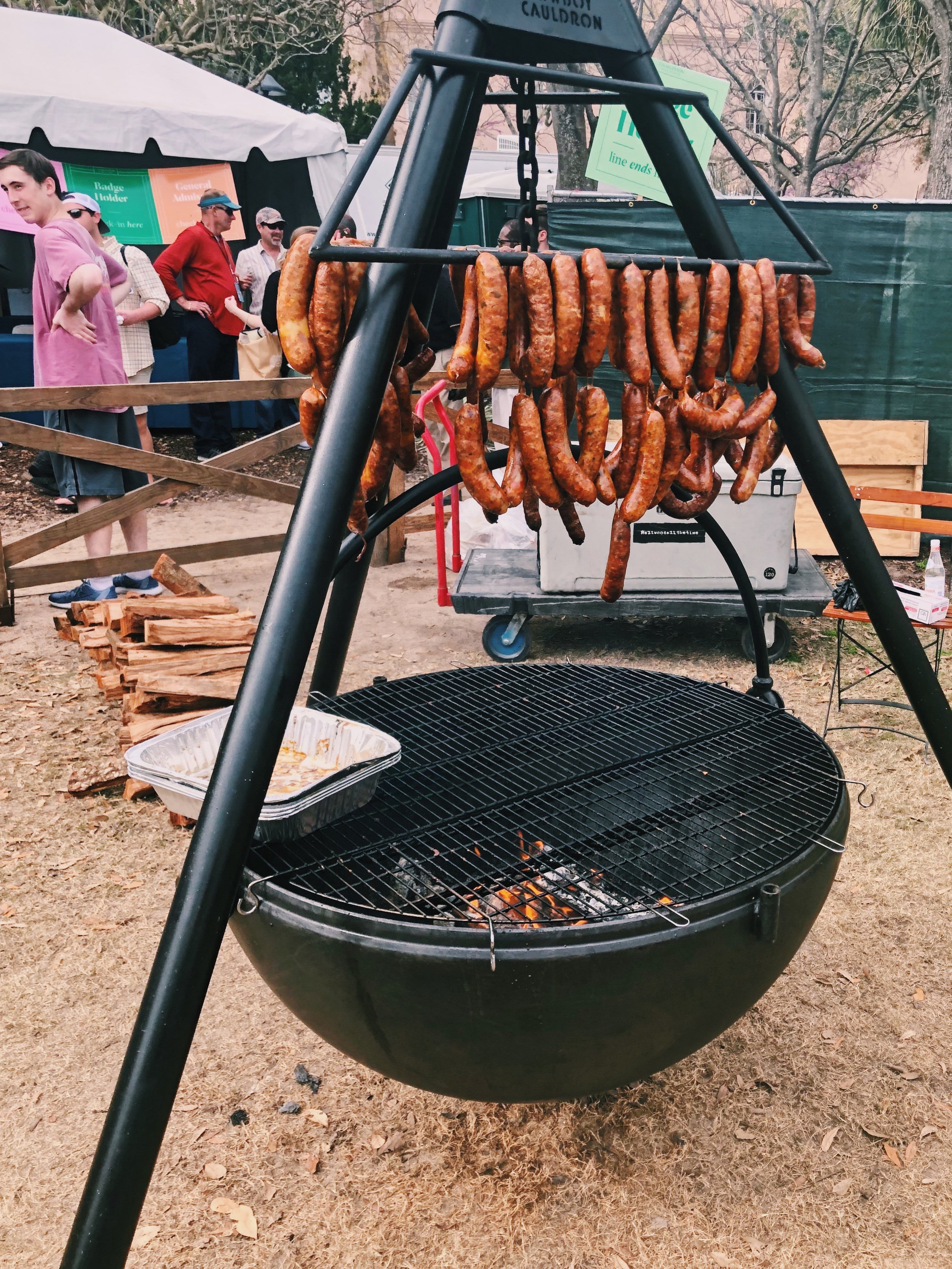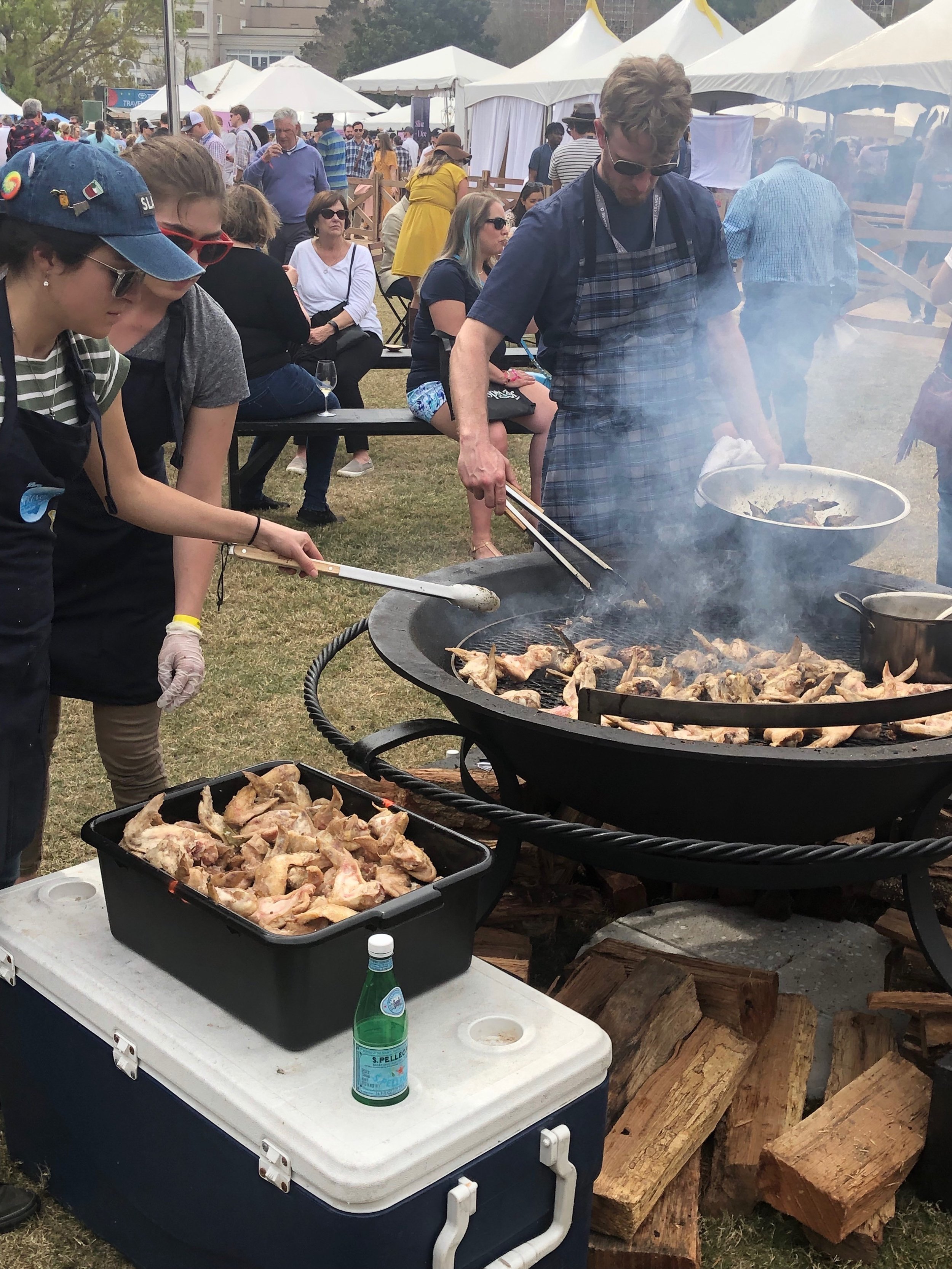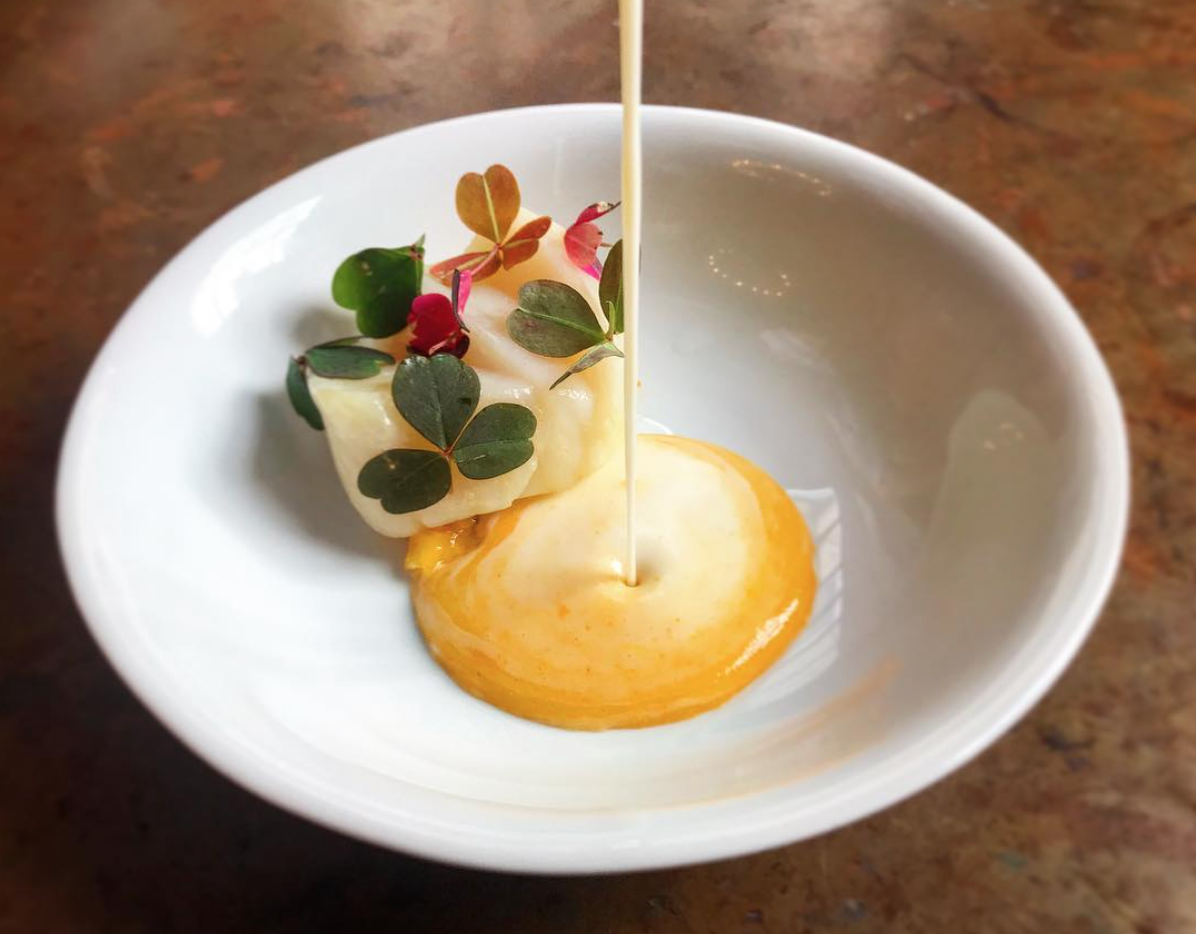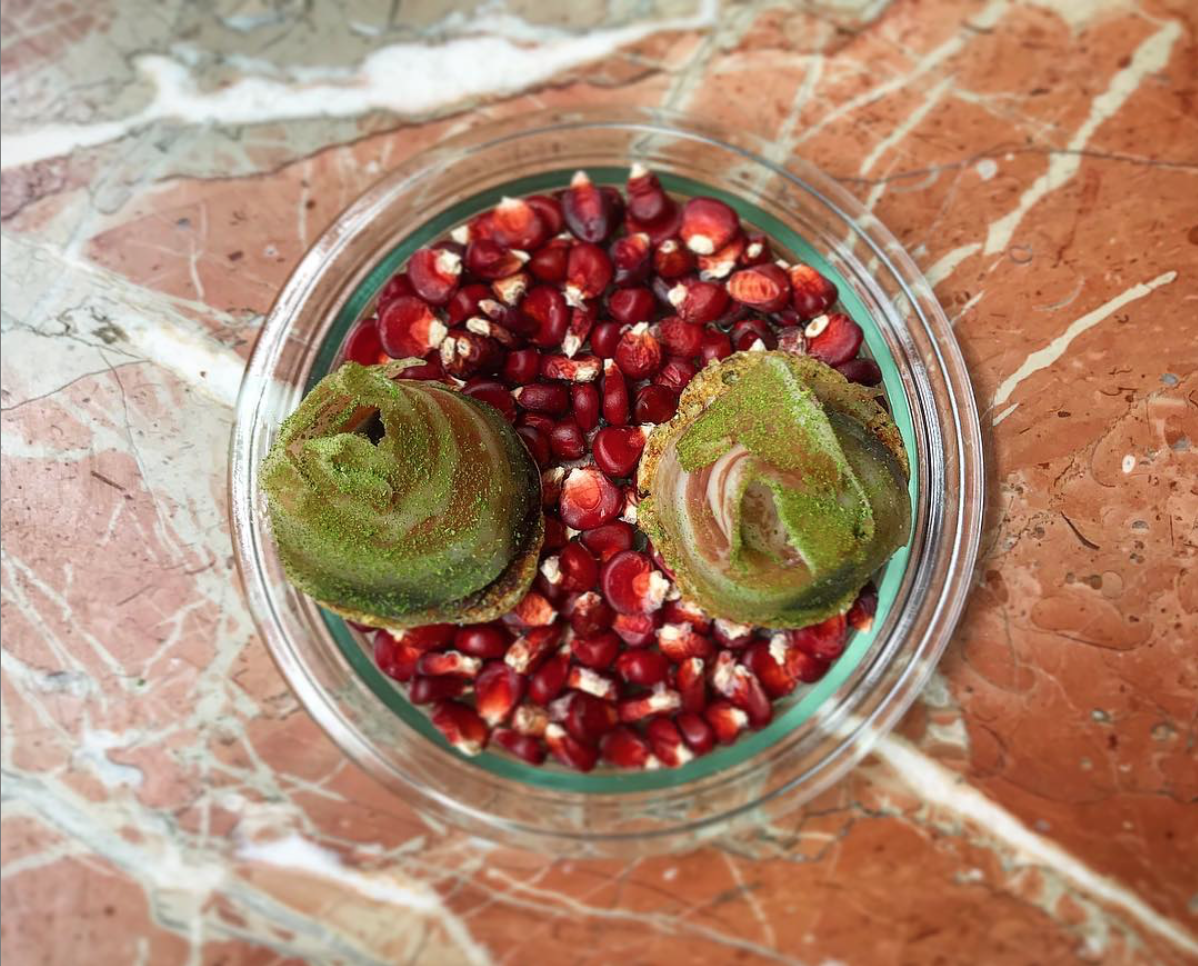A Food Festival's Purpose: Attending Charleston Wine and Food 2018
This year, I had the opportunity to attend the Charleston Wine and Food Festival. Its hub is the Culinary Village, where Marion square was transformed into an arena of beverage gardens, an artisan’s alley, an industry studio, endless food stalls, and a main stage of music and cooking demonstrations. Charleston was abuzz with culinary celebrities (Phil Rosenthal and Maneet Chauhan were in attendance), beer and wine enthusiasts, millennial foodies, hungry bachelorettes, locals and faraway visitor alike.
As soon as I arrived from a gloomy (and still snowy) New York to a sea of smiling faces and a warm and shining sun, I accepted the city’s promise of an excellent weekend, and so my fleeting but passionate romance with Charleston began. Although I did not purchase festival tickets beyond admittance to Saturday’s Culinary Village, it left my evenings free to wine and dine at some Charleston hotspots. I only had 72 hours in this fine city, after all! McCrady’s chef’s counter (once the temple of Sean Brock) is a performative, gastronomic spectacle, while Zero Restaurant within the Zero George Hotel provides one with an intimate and ever-changing seasonal feast wrapped in the comforts of a home. As result, my travels through not only filled my stomach, but also my mind with thoughts about our nation’s regional food cultures.
THE VILLAGE
I awoke on Saturday to a bright and temperate morning, my hotel window overlooking a port filled with catamarans, house boats, and dinghies bobbing contently in the water. I thought about breathing in that salty air, basking in the sun while knocking back a dozen briny oysters with a six-pack of crisp, refreshing beer. All that and before 9am. But I decided to pace myself, and determined that a more…conventional southern breakfast would suit me before heading to CHWAFF’s Culinary Village. I took a short drive to Marion Square and strolled down King Street to eventually take my place in line at Callie’s Biscuits. I overheard that the place was more packed than usual this morning; apparently Phil Rosenthal’s visit was broadcasted yesterday on local television, and now everyone wanted a bite of baked, buttery bliss. I have to say the 40-minute wait was well worth it. The biscuit was warm (all are made fresh), pillowy and flaky, a near-sensual experience as each layer of laminated dough crumbled and melted away in my mouth. The scrambled egg sandwiched between was creamy and fluffy, and I chose to top them off with sweet and tangy slow-roasted tomatoes. It is a decently sized breakfast sandwich, but I still had to hold myself back from ordering at least three more. This food-filled weekend’s mantra was undeniably going to be it’s a marathon, not a sprint.
After taking the time to digest and sip on my first iced coffeeof the new year, it was time to head to Marion Square. At the gates of the Culinary Village I saw eager attendees adorned with what they must have determined the uniform of CHWAFF. There were Kentucky Derby style hats and boldly printed garments. There were women wearing “bride” and “bachelorette” sashes, men in salmon shorts and navy jackets, an endless sea of boat shoes, and pastels…lots of pastels. I felt weary upon pondering that I had missed the memo on the dress code, but the infectious energy radiating off my fellow eaters and drinkers soon made me feel like a welcomed member to the Charleston affair. I walked into the village and the sensory assault unapologetically continues. To my right: a smoker and giant grill with fresh sausages already hanging from a singular rafter, readily soaking in the smoke’s wafting essence. On my left: a beer garden serving crispy lagers, puckering sours, and tart, bubbly ciders. Walking further, my eyes darted from booth to booth laid out in the Artisan’s Alley. There were cured meats, crystalline and umami-filled parmesan wheels, and small batch honeys, hot sauces, jellies and jams. The largest tent was the village’s roségarden, where various wines, champagnes, rosés (of course) and some spirits were made to savor while fraternizing on antique loveseats and armchairs.
If you think you won’t be there through the village’s entire opening (12-5pm), you’re wrong. You will. And I loved it. Remember, It’s a marathon, not a sprint. I take my first lap with a beer from the state’s own River Rat Brewing Co. I eye some chicken cooking on a grill and am hypnotized by the cook’s rhythmic toss of the mixing bowl that jostles a pile of succulent, juicy wings splashing in a seductively sticky, spicy sauce. I take a bite and the meat easily gives way from the bone, followed by a wood-smoked splash of juice filling the inside of my mouth.
The flesh is nearly creamy in texture, and it is only in the second bite that the heat from the mixture begins to flow over me like lava. The small flourish of kale salad accompanying this morsel was utterly necessary; the sweet apples and tangy dressing in tandem with the crisp, cold greens ensured that the third and final bite this wing’s well-deserved finale.
The frenzy continued: barbecued pork and beef, braised lamb, burgers, tacos, and seafood jambalaya. I noticed that some veteran participants carried small, cardboard trays with them in an attempt to collect 5-7 bites, then regroup with friends to distribute various food and drink among themselves. I (maybe selfishly) made a mental note to tell my friends to mark their calendars for next year. My third go-around consisted of buttermilk biscuits (sweet and savory), tater tots, bratwurst, mussels, clams, and—as the last bite of the day—two scoops from Charleston’s own Republic Ice Cream. Now, the drink: my first beer from River Rat was exciting, but I wanted to try something unexpected. I ventured over to the Owl’s Brews stall to try what they had labeled as “boozy teas”. I was skeptical but took a chance; I chose a white tea infused with watermelon and pomegranate. It was mellow and refreshing, with a floral brightness and sour zing both sweet and delightful. I continued on by tasting sour beers, IPAs, and a Guinness with a soft, salty, chewy pretzel the size of my head. I took a break after that to play some corn hole and giant connect four, two wisely added digestive distractions.
I am not the biggest fan of champagne, but my obstinate notions began to waver while watching an enthusiastic sommelier deliver his performance to a group of tasters. Before I knew it, I was among the next group to try the 4-champagne flight. Despite the unpleasant sensation in my mouth as it filled with fuzzy bubbles, I was in awe of our host’s deeply rooted passion. Not only were we educated about fermentation, corking and distribution, but he also shared with us the details of his life and his love for the annual CHWAFF. Indeed, this passion for food and drink emanating from ticketholders, cooks, purveyors was as radiant as the southern sun. It’s a good thing we had all that wine to keep us cool.
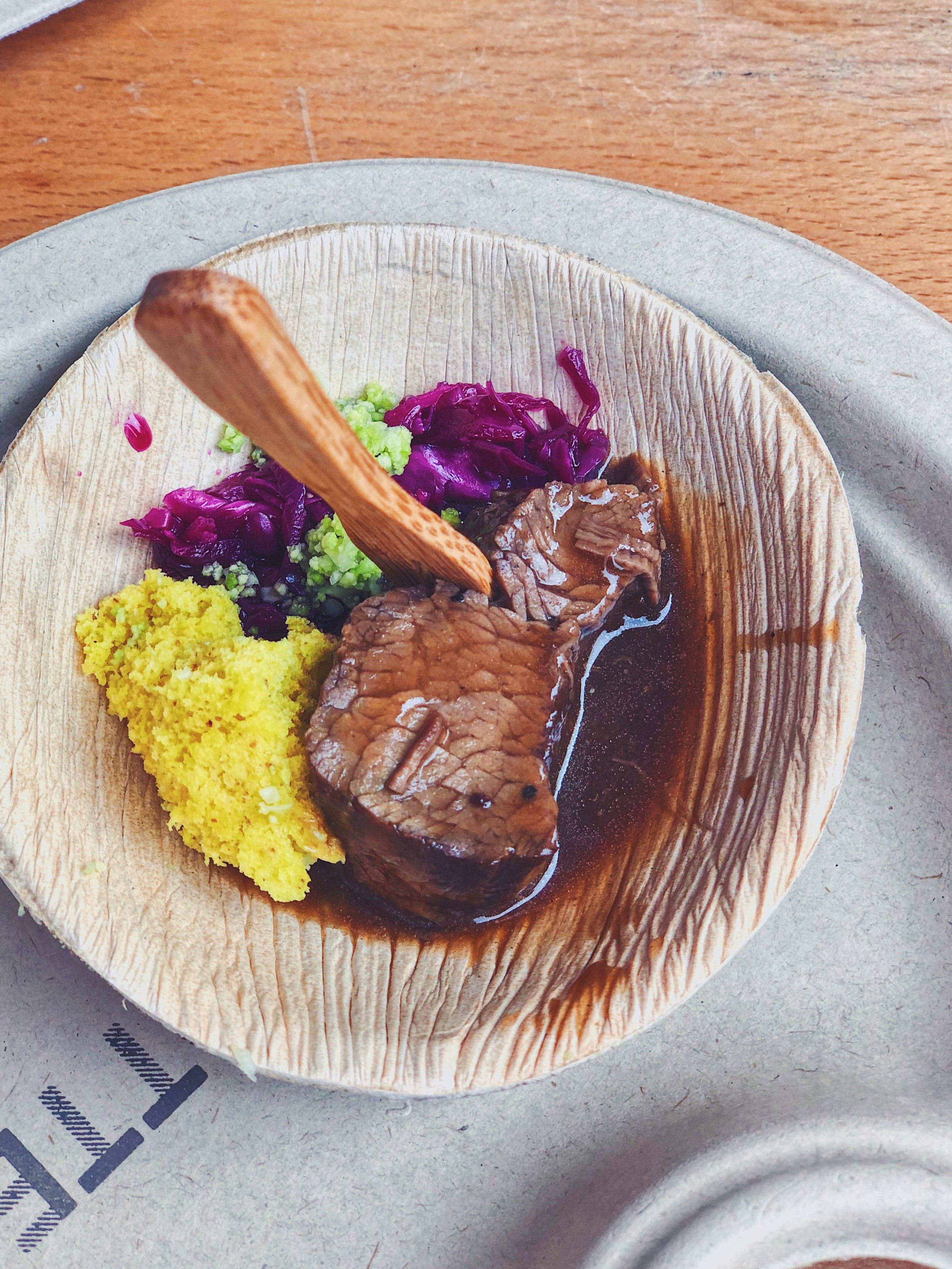


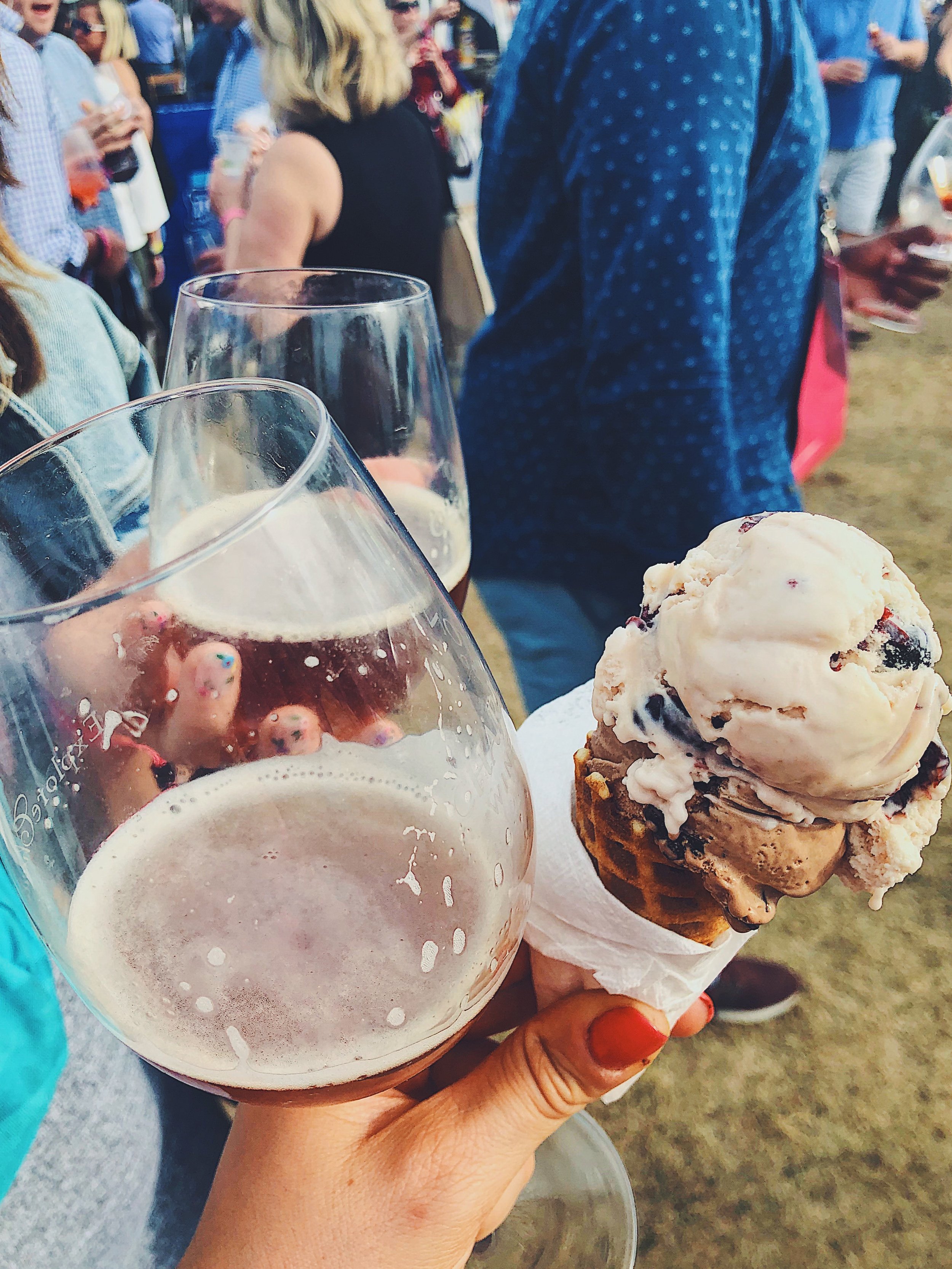



THE RESTAURANTS
For my first night in Charleston I dined at a two-faced national landmark called McCrady’s. Turning off the stretch of East Bay street, a short stroll down Unity Alley led me to the entrance of McCrady’s Tavern. Given its name, the energy and environment is what one might expect. It is subdued yet electric and the crowd is a laid-back mixture of young and old; yet they all seem to possess a mutual understanding that this Tavern is a safe haven for refuge and indulgence. Conversations appear as warm and as welcoming as the scents of butter and cooked meat hovering in the air. McCrady’s Tavern has thusly continued to be an ideal place for gathering since its founding in 1778, and it is famously noted to have been the venue for a dinner party thrown in honor of President George Washington.
My people-watching came to an end when the host told me my seat for my 9pm reservation was ready. I was led to an unassuming doorway adjacent to the Tavern’s bar and then ushered into McCrady’s (“Tavern” omitted)—the establishment’s fine dining, sexier twin. I admit that the stark contrast between the spaces was slightly awkward. As soon as that singular door is opened 22 pairs of eyes peek at you expectantly, in a way that makes you so bodily aware that you almost don’t want to indulge in a multi-course meal of food and drink. Almost. It’s a good thing that these eyes are actually gazing into McCrady’s open kitchen; the pass is found just a step down and on the left. When I take my lap around the counter and am seated in a lovely leather bar stool reminiscent of a comfortable enveloping banquette, I take in the entirety of the space and realize that it is utterly beautiful—our first president would have been proud.
Photo from restaurant’s website
The menu is evidently southern, taking a locavore, farm-to-table approach to ingredients readily accessible from the state and surrounding area. But as a fine dining establishment, executive chef Jim Stein does not hesitate to offer something just as luxurious asthe restaurant’sshimmering, golden ceiling: foie gras, caviar, and truffle “supplements” are mentioned even before I drape my napkin across my lap. So yes: there is glitz and glamor, but there is also an attention to detail at McCrady’s that is only accomplished through an extensive knowledge of and compassionate understanding toward food.
The performance begins with—of course—a briny barrier island oyster low lighted with sweet tastes of an ale from South Carolina’s Revelry Brewing Company. The additional citrus, notes of spice from ginger, and that acidic essence achieved only from lemongrass make it an exceptional first course, certainly whetting the apatite. What follows down the catwalk counter is another dish glowing with southern pride: jimmy red corn, sorghum, and ossabaw. Stein not only embraces the seed-saving history of the south but also pays his dues—as a contemporary chef—in full, cohesively executing the “heritage breed” movement in one small but well-crafted dish. The plate arrives sitting in a pool of crimson red corn kernels; its edible parts are a corn and sorghum corncake dolloped with a slice of ossabaw pork (a feral Georgia-native breed); it is sprinkled with bay leaf powder. These sweet and salty tastes linger with a gently herbaceous flavor, and while the fat from the pork and buttery crumbles of the corn cake melt away, you are left with only one wish: that the dish were made large enough for a fork and knife.
Making a return to seafood, a scallop arrives topped with few sprigs of wood sorrel. The dark green herb highlights the mollusk’s milky white hue which ascribes an undeniable characteristic of purity to the overall presentation. This is only further illuminated as my server pours over—seemingly in slow motion—a blanquette sauce mixed with kumquat. A complete bite alerts you to the flavor of the citrus, but it is not aggressively sour. I hypothesized that the earthy wood sorrel controlled the sweetness of the lightly treated scallop—in the mouth it is like sliding a knife through a block of warm butter—while its herbaceous notes simultaneously deepened the richness of the blanquette. As a result, that small tinge of kumquat becomes the equalizer, creating a symphonic dish that is both harmonious and complex.
Photos are from the restaurant’s Instagram
Other staples to the menu include the Instagram-famous, arrestingly black tart shells filled with a foie gras mouse. The velvety duck liver is lifted by the anise flavors of licorice and fennel and rounded out with a sweet lingonberry jam; visually, the tones of black and red are quite enticing, but all that work only pays off after tasting the dish. Indeed, the tart is stylized and ready for an unrelenting stream of “likes” vibrating through your phone; but it is also very tasty. Take a photo and enjoy.
13 courses later, the meal and my first introduction to Charleston’s fancy food scene comes to an end. All that is left to say is that the food was impeccable and inventive; the staff was attentive and warm; the ambiance friendly and unpretentious.
At Zero Restaurant, I embark on a journey similar yet incredibly different. Like McCrady’s,the layout of the space is just as awkward: a short walk through the hotel garden led me to a door that opened directly into the kitchen. It was so off-putting that I nearly excused myself, convinced I had somehow entered the restaurant through the back. But the cooks smiled up at me silently and—low and behold—a turn to my right exposed the hotel’s receptionist at the desk. I had arrived for my 8pm reservation right on time and was welcomed with a warmth typically reserved for welcoming dear friends into your home. Southern charm at its finest.
The host took me past a small bar with no more than 8 seats and into the dining room. The space is a little cramped; the size of a small living room filled with banquettes and tables instead of a sofa and an armchair. But I did not complain as I was nestled away in a corner; I felt secluded and comfortable…An ideal environment for indulgence. That southern charm continued as my waiter was a gentleman in every sense of the word; he possessed an admittedly attractive boyish countenance but also had an alluring aura of authority. I had to restrain myself from writing my phone number on the receipt. The hospitality truly refuses to waver: when my dining companion declined the wines meant to accompany the set menu (due to an allergy), the waiter seamlessly excused himself only to return with a word from the mixologist: he was going to provide a complementary cocktail service with the food. Even better: I was still able to enjoy the wine pairing…all was right with the world.
4 snacks arrive first: shrimp toast, oysters on the half, Anson Mills white corn, and the apparently iconic “potted plant”. It is a tiny, white and peppery radish submerged in creamy, faintly sweet, and custard-like butter. The “dirt” is playfully made of puffed red quinoa. It was so undeniably cute I almost did not want to like it. Ultimately, though, it is a dish that epitomizes the simplicity of ingredients whose awesome flavor components can be rightfully highlighted when in the hands of talented and knowledgeable cooks. Iconic indeed.
Photo from Easton Porter Group
The lighting of the restaurant proves challenging for an average phone camera, but that may be part of the point. I kept my device in the confines of my bag (most of the time) and let my senses replace my modern M.O. of memory-making. My favorite dish of the evening was undoubtedly a royal red shrimp with popcorn, calamansi, and coconut. I was told that calamansi is a fruit traditionally found in Filipino cuisine. It tastes like a citrusy hybrid of—surprise!—kumquat and mandarin orange. Akin to McCrady’s, the citrus in this dish becomes a vital component for its accent and complexity. The shrimp’s flesh snaps with the first bite and its sumptuous texture melts in the mouth like a square of decadent chocolate. These waves of pleasure continue as the coconut’s gentle veil of nuttiness is lifted by that citrus of the calamansi. The popcorn could have been omitted, but the crunchy texture was salty and playful, infusing some fun into a course so undeniably sexy.
Another favored seafood-forward dish was koji-cured Hamachi with two colorful sauces: one is made from blueberries; it is vacuously black and purple like a night sky. The other is reminiscent of a tangerine, but I am corrected and told it is passion fruit. The firm yet silky fish allows your teeth to slide through its flesh with great ease, and its mellow sweetness becomes slightly more savory thanks to that koji, the championing umami agent. Filling your mouth with more delight is the deep juiciness of the blueberry. Finally, the polite interruption of zingy passion fruit to take you into one bite after the next. Given the dish’s Jackson Pollock-like aesthetic, no taste is ever exactly the same, but being able to pick your own flavorsome adventure makes the plate even more enjoyable.
Other menu items include a tile fish that may be highlighted (for an additional fee) with white truffle followed by a roasted Manchester farms quail begging to be sprinkled with earthy black truffles (also for additional fee); I love quail and thusly could not resist. The musty truffles highlighted the smoky essence of a bird expertly cooked over fire. Finally, rounding out the thoughtfully portioned and well-paced 8 courses were two desserts. Rather strategically the first was a cleansing ginger granita, followed by a rich and robust (70%) chocolate tart that would have been more than satisfactory even at half its original size. However, the miso caramel seductively reels you in for one bite after another, and in moments it is gone…those thoughts about wishing it were smaller now seem blasphemous.
Photo from the restaurant’s Instagram
REFLECTIONS
I think that it is more than fair to assert that Charleston loves its food and its people. The city is welcoming and its citizens possess a national pride that is more inclusive than exclusive. Thus there is no aspect—except maybe in its food—of the city that preaches “holier than thou”. To me, it seems that the city’s food scene is an amalgamation of something so unapologetically southern and, in that sense, a regional boast of pride. I have not experienced this sensation anywhere else in the United States: in the south, one is made to taste food strictly based on locality, allowing us to further question the importance of food in modern society. Food is not just for nourishment. When treated properly, distributed equitably, and sourced sustainably, it becomes a vehicle for education, nationalism, and nourishment.
As a result, my experience at Charleston Wine and Food became much more than a celebration of the south’s culinary heritage. Yes, this adventure has given me the chance to further explore the food of the south; but it has also allowed me to question what a food festival can be. It may come as a surprise to learn that no more than 20 minutes away from Charleston’s Marion Square is North Charleston, one of 11 of the state’s food deserts. It may also be shocking to learn that South Carolina households were ranked 41 out of 50 in levels of food insecurity in 2018. Charleston Wine and Food does not hide its demographics: this year there were just over 29,000 attendees. 90% of ticketholders were college educated. 51% reported a household income “$150K+”; 36% “reported $200K+”. As a nonprofit organization, CHWAFF generated a whopping $2,048,000 in total taxes, rendering an “economic impact” of $15,300,000. Finally, the festival partners with One80 Place to aid its Culinary Job Training and Food Rescue Programs, priding itself as one of the greatest stewards of the city. But what happens after those 5 weeks of job training, and what are the criteria in place in order to access those resources? Furthermore, how is the annual 220,000lbs of salvaged food distributed? These questions are to be addressed in a future article, but next time you go to a food hall (mine are the Canal Street Market, Urban Space Vanderbilt, Mercado Little Spain), or food festival (Eeeeeats Con, Queen’s Night Market, New York Wine and Food), acknowledge the abundance and do not be afraid to ask what your favorite businesses are doing to decrease food waste and alleviate food insecurity. Ultimately, we are all responsible for our nation’s food system, and I believe that if we truly want to enjoy its abundance, then we must create, discover, and cultivate distribution opportunities.

